Sociology Report: Leisure Education Plan for Workplace Employees
VerifiedAdded on 2022/10/16
|6
|1010
|249
Report
AI Summary
This report examines the concept of leisure education and its application within the workplace to enhance employee well-being. It begins with a historical perspective, tracing the evolution of leisure activities and their integration into work environments. The report then outlines a practical leisure education plan, proposing specific activities such as designated spaces for relaxation, and short weekly fun activities designed to reduce stress and improve job satisfaction. The expected outcomes of this plan include increased life satisfaction, improved job satisfaction, and enhanced self-esteem among employees. The report emphasizes the importance of leisure in mitigating the negative effects of workplace stress and promoting a healthier work-life balance. It concludes by highlighting the potential for leisure activities to positively impact employee performance and overall quality of life. The report references key studies and literature to support its arguments and recommendations.
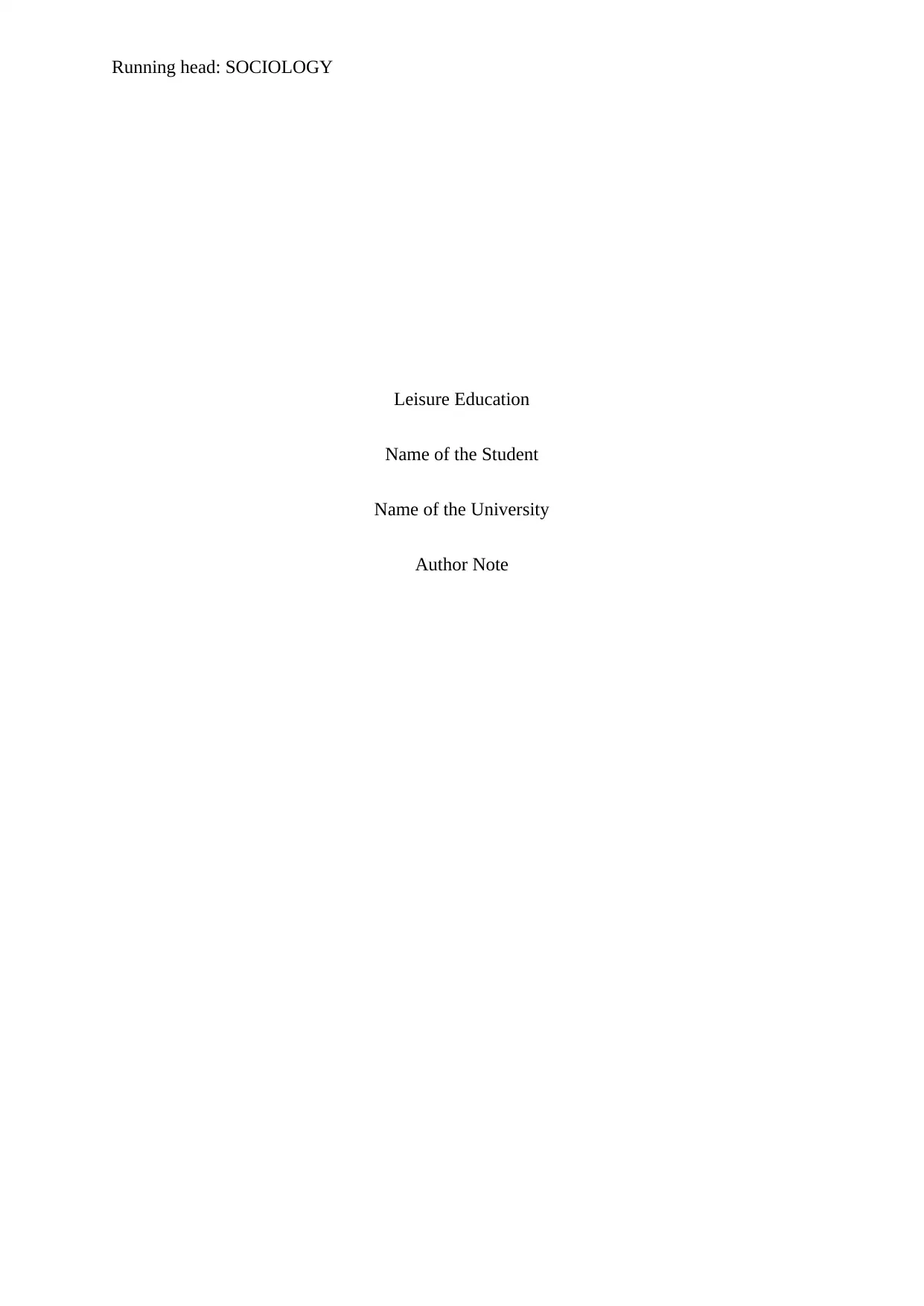
Running head: SOCIOLOGY
Leisure Education
Name of the Student
Name of the University
Author Note
Leisure Education
Name of the Student
Name of the University
Author Note
Paraphrase This Document
Need a fresh take? Get an instant paraphrase of this document with our AI Paraphraser
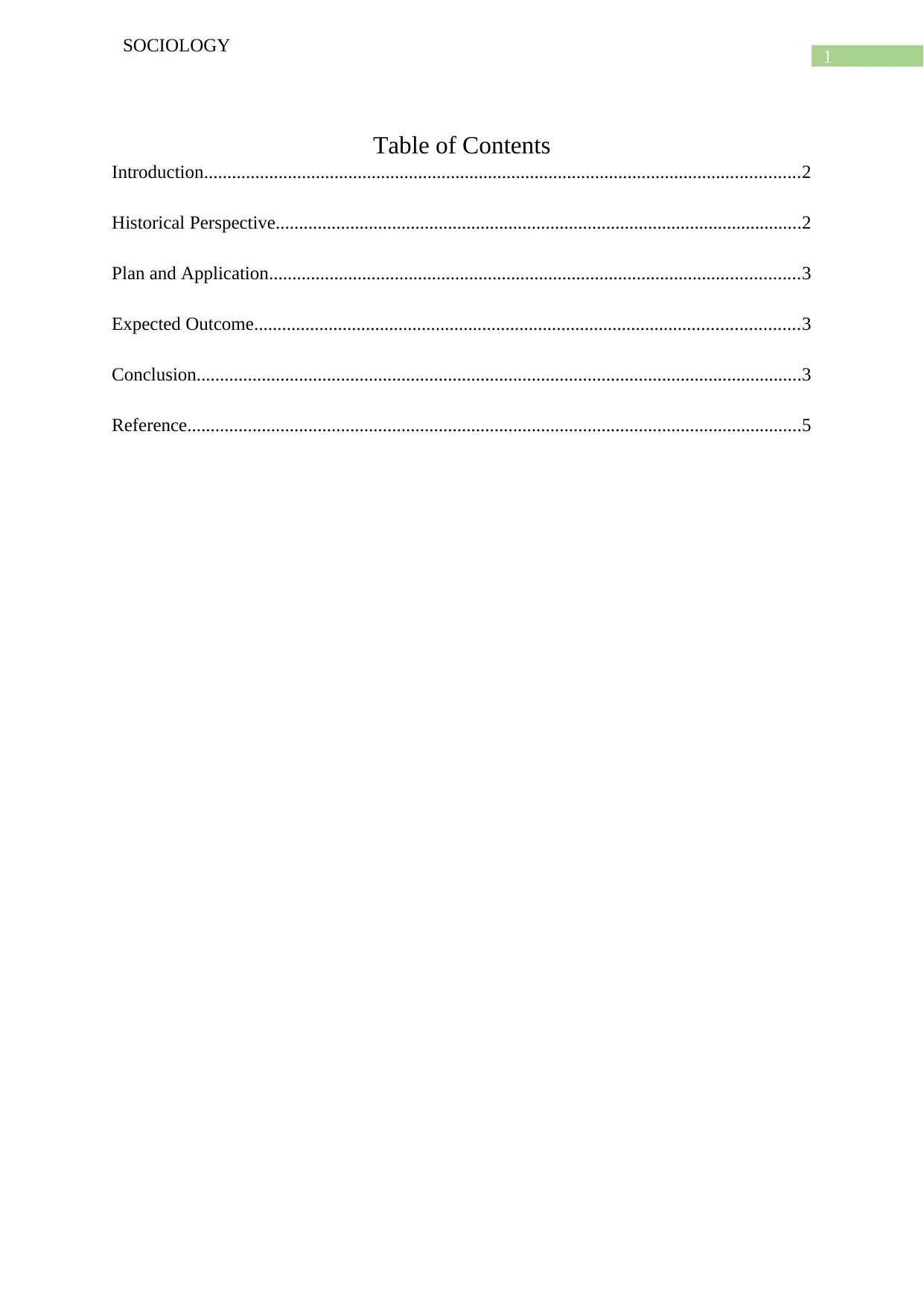
1
SOCIOLOGY
Table of Contents
Introduction................................................................................................................................2
Historical Perspective.................................................................................................................2
Plan and Application..................................................................................................................3
Expected Outcome.....................................................................................................................3
Conclusion..................................................................................................................................3
Reference....................................................................................................................................5
SOCIOLOGY
Table of Contents
Introduction................................................................................................................................2
Historical Perspective.................................................................................................................2
Plan and Application..................................................................................................................3
Expected Outcome.....................................................................................................................3
Conclusion..................................................................................................................................3
Reference....................................................................................................................................5
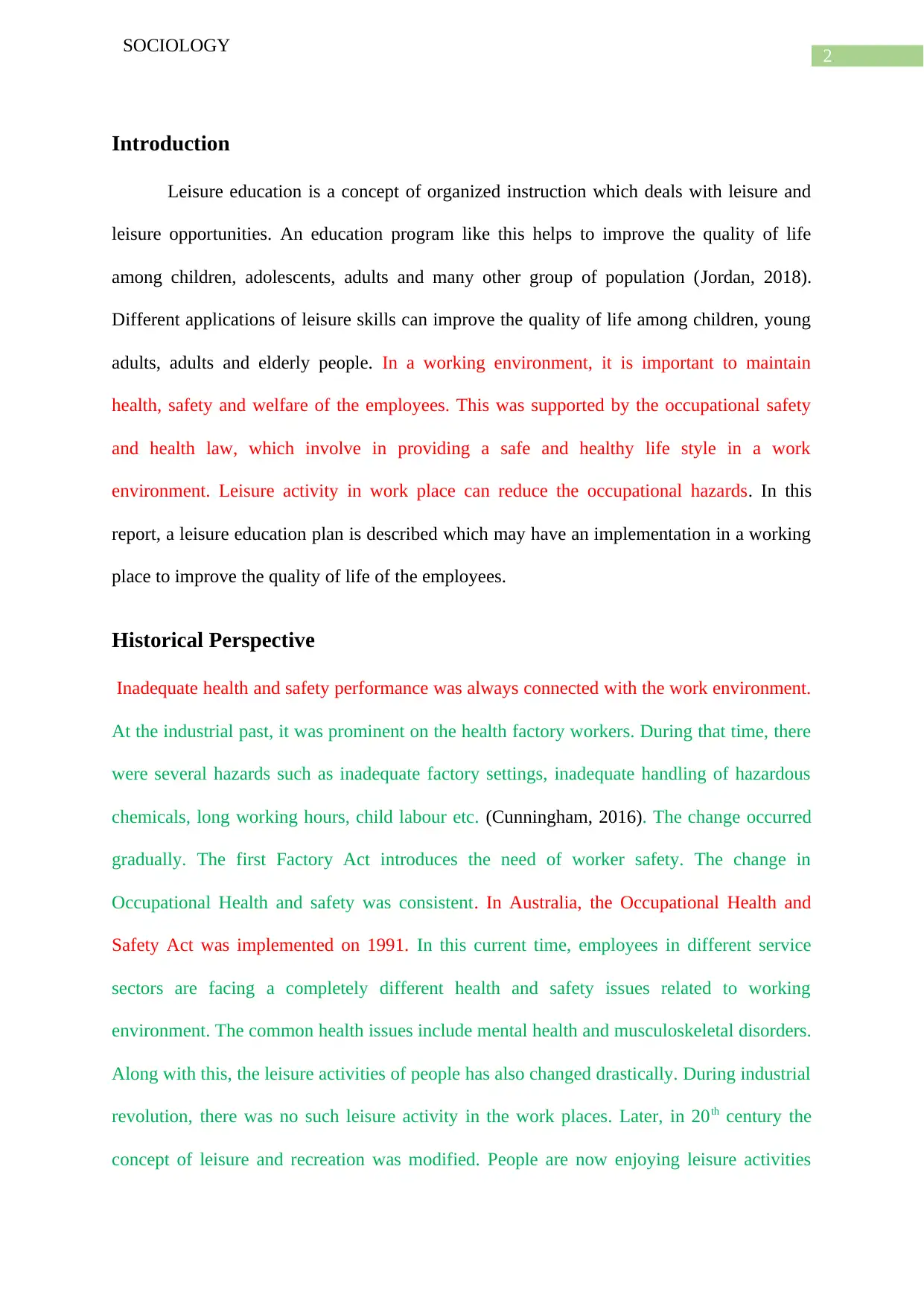
2
SOCIOLOGY
Introduction
Leisure education is a concept of organized instruction which deals with leisure and
leisure opportunities. An education program like this helps to improve the quality of life
among children, adolescents, adults and many other group of population (Jordan, 2018).
Different applications of leisure skills can improve the quality of life among children, young
adults, adults and elderly people. In a working environment, it is important to maintain
health, safety and welfare of the employees. This was supported by the occupational safety
and health law, which involve in providing a safe and healthy life style in a work
environment. Leisure activity in work place can reduce the occupational hazards. In this
report, a leisure education plan is described which may have an implementation in a working
place to improve the quality of life of the employees.
Historical Perspective
Inadequate health and safety performance was always connected with the work environment.
At the industrial past, it was prominent on the health factory workers. During that time, there
were several hazards such as inadequate factory settings, inadequate handling of hazardous
chemicals, long working hours, child labour etc. (Cunningham, 2016). The change occurred
gradually. The first Factory Act introduces the need of worker safety. The change in
Occupational Health and safety was consistent. In Australia, the Occupational Health and
Safety Act was implemented on 1991. In this current time, employees in different service
sectors are facing a completely different health and safety issues related to working
environment. The common health issues include mental health and musculoskeletal disorders.
Along with this, the leisure activities of people has also changed drastically. During industrial
revolution, there was no such leisure activity in the work places. Later, in 20th century the
concept of leisure and recreation was modified. People are now enjoying leisure activities
SOCIOLOGY
Introduction
Leisure education is a concept of organized instruction which deals with leisure and
leisure opportunities. An education program like this helps to improve the quality of life
among children, adolescents, adults and many other group of population (Jordan, 2018).
Different applications of leisure skills can improve the quality of life among children, young
adults, adults and elderly people. In a working environment, it is important to maintain
health, safety and welfare of the employees. This was supported by the occupational safety
and health law, which involve in providing a safe and healthy life style in a work
environment. Leisure activity in work place can reduce the occupational hazards. In this
report, a leisure education plan is described which may have an implementation in a working
place to improve the quality of life of the employees.
Historical Perspective
Inadequate health and safety performance was always connected with the work environment.
At the industrial past, it was prominent on the health factory workers. During that time, there
were several hazards such as inadequate factory settings, inadequate handling of hazardous
chemicals, long working hours, child labour etc. (Cunningham, 2016). The change occurred
gradually. The first Factory Act introduces the need of worker safety. The change in
Occupational Health and safety was consistent. In Australia, the Occupational Health and
Safety Act was implemented on 1991. In this current time, employees in different service
sectors are facing a completely different health and safety issues related to working
environment. The common health issues include mental health and musculoskeletal disorders.
Along with this, the leisure activities of people has also changed drastically. During industrial
revolution, there was no such leisure activity in the work places. Later, in 20th century the
concept of leisure and recreation was modified. People are now enjoying leisure activities
⊘ This is a preview!⊘
Do you want full access?
Subscribe today to unlock all pages.

Trusted by 1+ million students worldwide
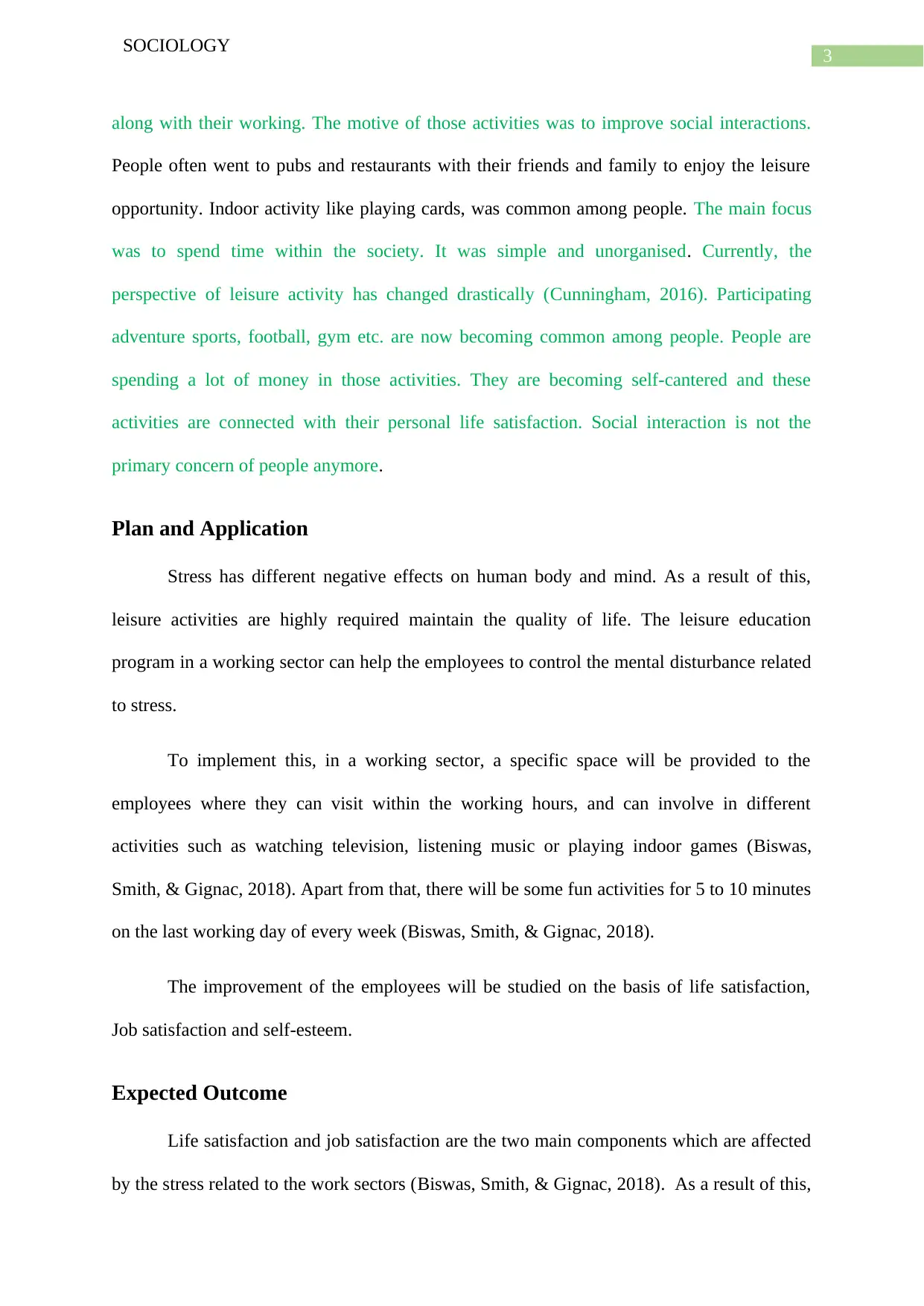
3
SOCIOLOGY
along with their working. The motive of those activities was to improve social interactions.
People often went to pubs and restaurants with their friends and family to enjoy the leisure
opportunity. Indoor activity like playing cards, was common among people. The main focus
was to spend time within the society. It was simple and unorganised. Currently, the
perspective of leisure activity has changed drastically (Cunningham, 2016). Participating
adventure sports, football, gym etc. are now becoming common among people. People are
spending a lot of money in those activities. They are becoming self-cantered and these
activities are connected with their personal life satisfaction. Social interaction is not the
primary concern of people anymore.
Plan and Application
Stress has different negative effects on human body and mind. As a result of this,
leisure activities are highly required maintain the quality of life. The leisure education
program in a working sector can help the employees to control the mental disturbance related
to stress.
To implement this, in a working sector, a specific space will be provided to the
employees where they can visit within the working hours, and can involve in different
activities such as watching television, listening music or playing indoor games (Biswas,
Smith, & Gignac, 2018). Apart from that, there will be some fun activities for 5 to 10 minutes
on the last working day of every week (Biswas, Smith, & Gignac, 2018).
The improvement of the employees will be studied on the basis of life satisfaction,
Job satisfaction and self-esteem.
Expected Outcome
Life satisfaction and job satisfaction are the two main components which are affected
by the stress related to the work sectors (Biswas, Smith, & Gignac, 2018). As a result of this,
SOCIOLOGY
along with their working. The motive of those activities was to improve social interactions.
People often went to pubs and restaurants with their friends and family to enjoy the leisure
opportunity. Indoor activity like playing cards, was common among people. The main focus
was to spend time within the society. It was simple and unorganised. Currently, the
perspective of leisure activity has changed drastically (Cunningham, 2016). Participating
adventure sports, football, gym etc. are now becoming common among people. People are
spending a lot of money in those activities. They are becoming self-cantered and these
activities are connected with their personal life satisfaction. Social interaction is not the
primary concern of people anymore.
Plan and Application
Stress has different negative effects on human body and mind. As a result of this,
leisure activities are highly required maintain the quality of life. The leisure education
program in a working sector can help the employees to control the mental disturbance related
to stress.
To implement this, in a working sector, a specific space will be provided to the
employees where they can visit within the working hours, and can involve in different
activities such as watching television, listening music or playing indoor games (Biswas,
Smith, & Gignac, 2018). Apart from that, there will be some fun activities for 5 to 10 minutes
on the last working day of every week (Biswas, Smith, & Gignac, 2018).
The improvement of the employees will be studied on the basis of life satisfaction,
Job satisfaction and self-esteem.
Expected Outcome
Life satisfaction and job satisfaction are the two main components which are affected
by the stress related to the work sectors (Biswas, Smith, & Gignac, 2018). As a result of this,
Paraphrase This Document
Need a fresh take? Get an instant paraphrase of this document with our AI Paraphraser
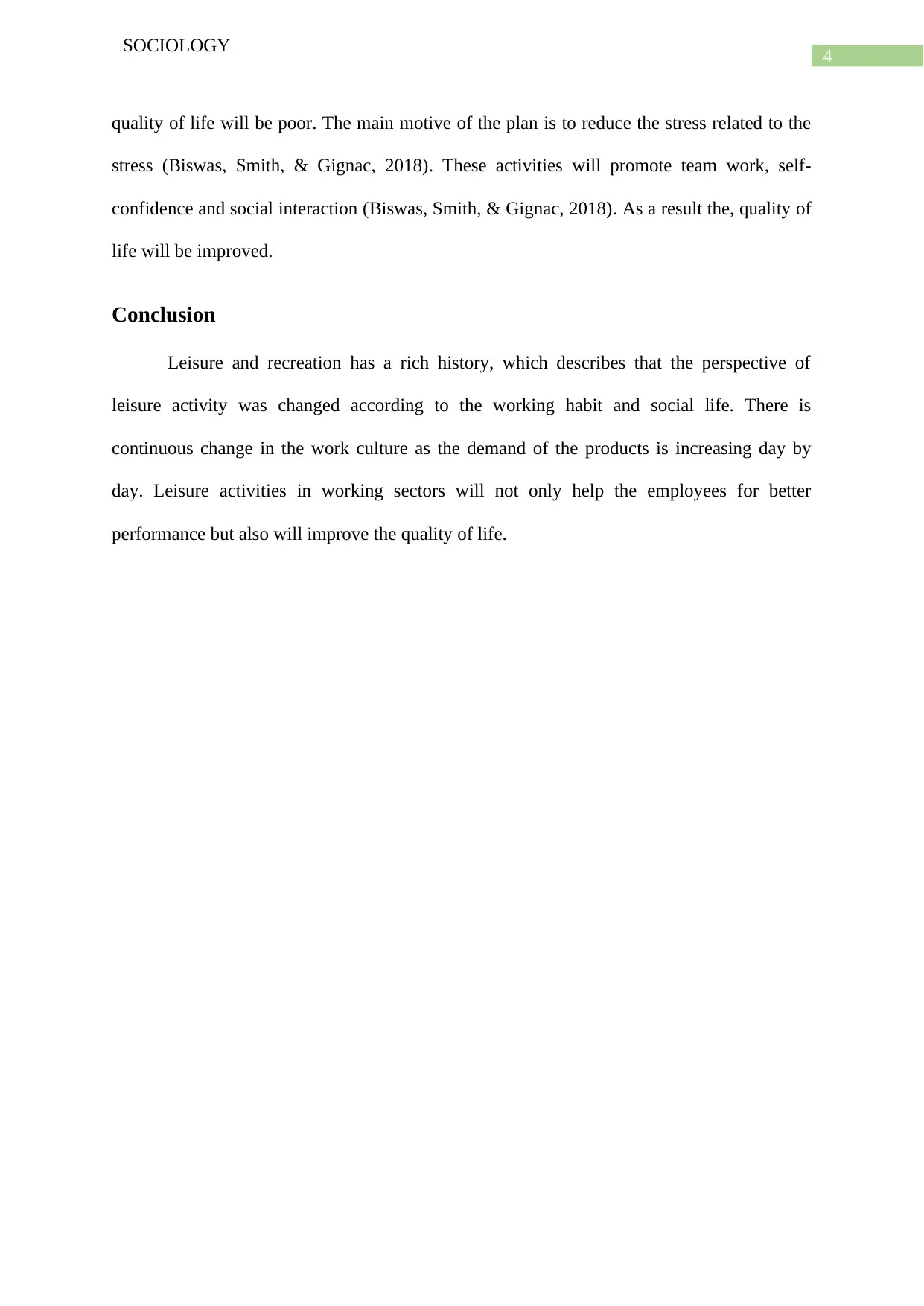
4
SOCIOLOGY
quality of life will be poor. The main motive of the plan is to reduce the stress related to the
stress (Biswas, Smith, & Gignac, 2018). These activities will promote team work, self-
confidence and social interaction (Biswas, Smith, & Gignac, 2018). As a result the, quality of
life will be improved.
Conclusion
Leisure and recreation has a rich history, which describes that the perspective of
leisure activity was changed according to the working habit and social life. There is
continuous change in the work culture as the demand of the products is increasing day by
day. Leisure activities in working sectors will not only help the employees for better
performance but also will improve the quality of life.
SOCIOLOGY
quality of life will be poor. The main motive of the plan is to reduce the stress related to the
stress (Biswas, Smith, & Gignac, 2018). These activities will promote team work, self-
confidence and social interaction (Biswas, Smith, & Gignac, 2018). As a result the, quality of
life will be improved.
Conclusion
Leisure and recreation has a rich history, which describes that the perspective of
leisure activity was changed according to the working habit and social life. There is
continuous change in the work culture as the demand of the products is increasing day by
day. Leisure activities in working sectors will not only help the employees for better
performance but also will improve the quality of life.
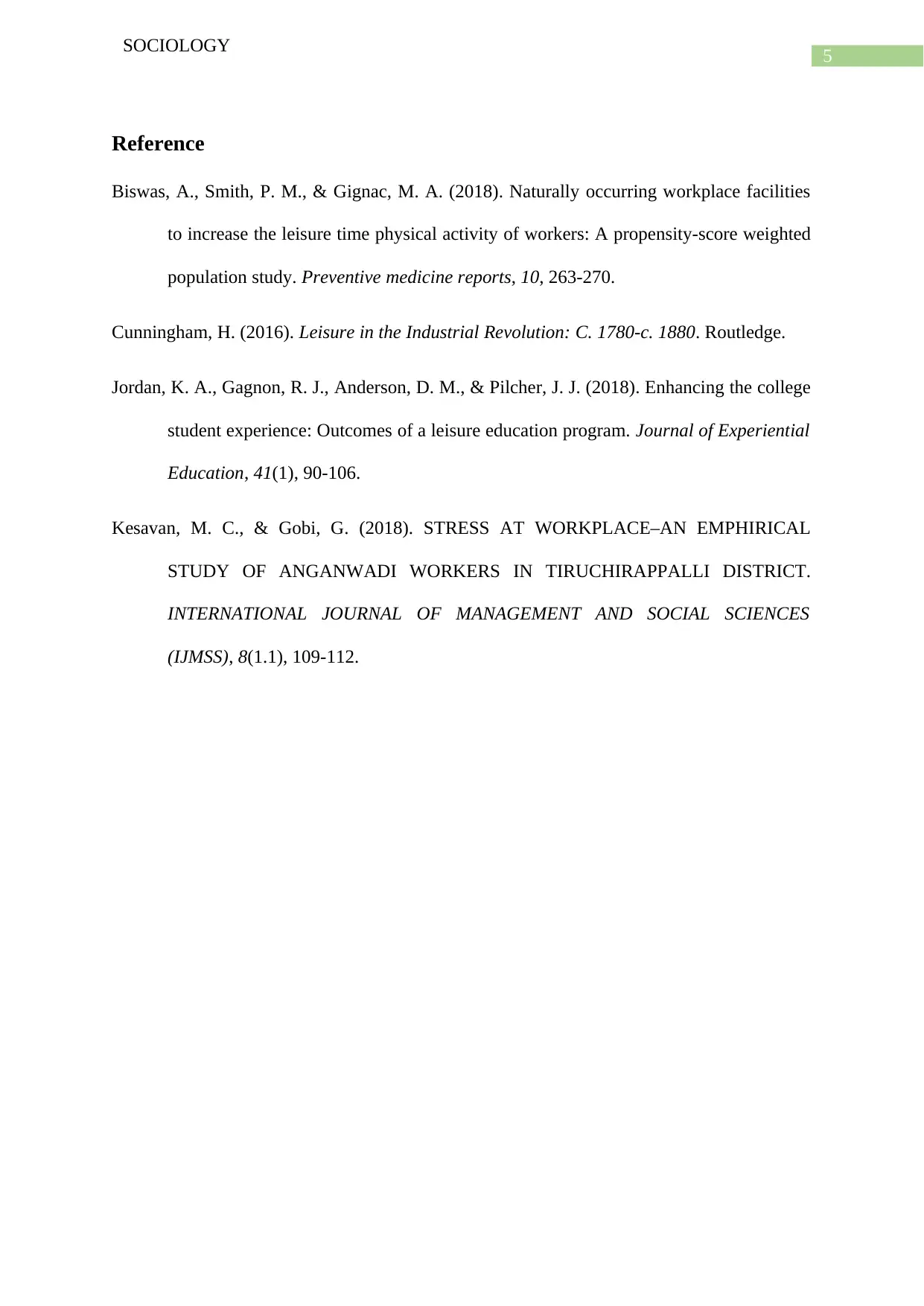
5
SOCIOLOGY
Reference
Biswas, A., Smith, P. M., & Gignac, M. A. (2018). Naturally occurring workplace facilities
to increase the leisure time physical activity of workers: A propensity-score weighted
population study. Preventive medicine reports, 10, 263-270.
Cunningham, H. (2016). Leisure in the Industrial Revolution: C. 1780-c. 1880. Routledge.
Jordan, K. A., Gagnon, R. J., Anderson, D. M., & Pilcher, J. J. (2018). Enhancing the college
student experience: Outcomes of a leisure education program. Journal of Experiential
Education, 41(1), 90-106.
Kesavan, M. C., & Gobi, G. (2018). STRESS AT WORKPLACE–AN EMPHIRICAL
STUDY OF ANGANWADI WORKERS IN TIRUCHIRAPPALLI DISTRICT.
INTERNATIONAL JOURNAL OF MANAGEMENT AND SOCIAL SCIENCES
(IJMSS), 8(1.1), 109-112.
SOCIOLOGY
Reference
Biswas, A., Smith, P. M., & Gignac, M. A. (2018). Naturally occurring workplace facilities
to increase the leisure time physical activity of workers: A propensity-score weighted
population study. Preventive medicine reports, 10, 263-270.
Cunningham, H. (2016). Leisure in the Industrial Revolution: C. 1780-c. 1880. Routledge.
Jordan, K. A., Gagnon, R. J., Anderson, D. M., & Pilcher, J. J. (2018). Enhancing the college
student experience: Outcomes of a leisure education program. Journal of Experiential
Education, 41(1), 90-106.
Kesavan, M. C., & Gobi, G. (2018). STRESS AT WORKPLACE–AN EMPHIRICAL
STUDY OF ANGANWADI WORKERS IN TIRUCHIRAPPALLI DISTRICT.
INTERNATIONAL JOURNAL OF MANAGEMENT AND SOCIAL SCIENCES
(IJMSS), 8(1.1), 109-112.
⊘ This is a preview!⊘
Do you want full access?
Subscribe today to unlock all pages.

Trusted by 1+ million students worldwide
1 out of 6
Related Documents
Your All-in-One AI-Powered Toolkit for Academic Success.
+13062052269
info@desklib.com
Available 24*7 on WhatsApp / Email
![[object Object]](/_next/static/media/star-bottom.7253800d.svg)
Unlock your academic potential
Copyright © 2020–2025 A2Z Services. All Rights Reserved. Developed and managed by ZUCOL.



